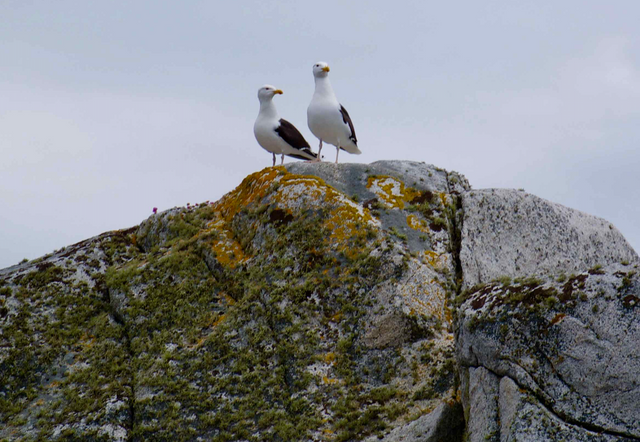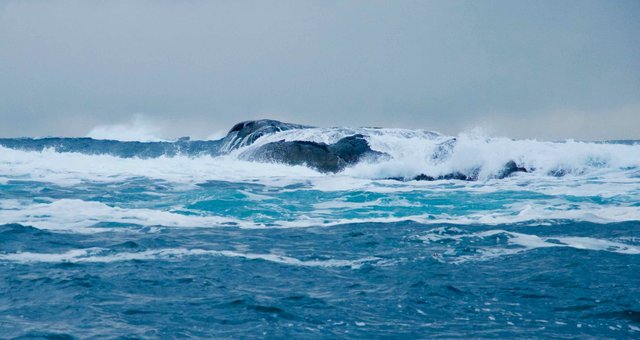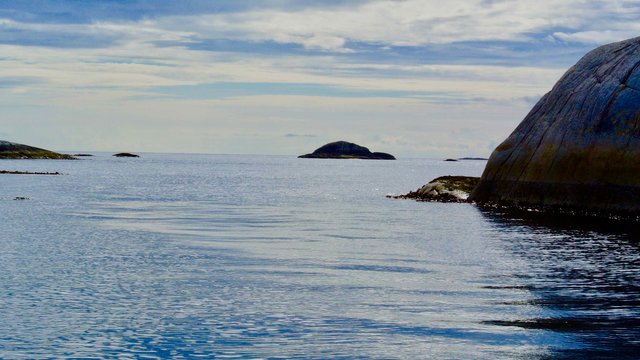Seagull, granite rocks, sea in storm and calm
The seagull in the pictures is the Great Black-backed gull (Larus marinus).
It is the largest of the gulls in Norway. It has a thick neck and a strong beak. The body is mostly white, but the wings are black. The feet are pale pink.
The Great Black-backed gull nest in the North Atlantic both on the coast of North America and in Northern Europe.
The size is 70-80 cm land, and this seagull can have a weight of about 1500-2500 grams.
The juveniles are brown-spotted and only get their adult feathers when they are 4 to 5 years old.
The pictures also show granite rocks that are quite common on the northern part of Bømlo. The white granite cliffs are beautiful to look at. The last two photos show the contrast between quiet weather and storm with large waves and foam.






Beautiful! I love your pictures of beautiful birds.
And I really liked the granite rocks.
I have not met such in Russia, because I rarely leave the city :-)
Nice that you like the pictures of the gulls and the granite cliffs @Singa
I am lucky to be able to take a boat trip and experience this beautiful nature. And it is preferably in the summer that I visit this area.
Wonderful pictures! I love everything related to birds. Similar, large seagulls live in the Crimea. About forty years ago, such a seagull left me a scar on my arm. He did not heal for a long time, but now he is no longer visible. Someone shot a seagull from an underwater gun. He wounded her in the wing. She had a broken wing. I was still quite a child and took a seagull from the water. She was a little smaller than me. She gave me a bite. It was a very strong cotton and many small teeth. A very unpleasant memory. But now I'm having fun remembering this. These seagulls recaptured all of eastern Europe, more precisely, all the sea coasts of the east. Not less seagulls, I liked the images of stone cliffs. This is a volcanic rock, I think. It was a discovery for me that there are 4 volcanoes in Norway, I did not know about it before. Your post has become an excellent motivation for me to read about Norway. But, in Wikipedia, it is not entirely clear; 4 names are indicated there, but only two coordinates. Are these 2 volcanoes with 2 names each, or are there 4 volcanoes there?
When it comes to birds, we also have a common interest @Barski.
I do not have such dramatic experiences with birds as the one you describe in your comment.
Still, I have a memory from 7-8 years of age. Just next to the house where I lived, The Eurasian Magpie (Pica pica) had built a nest. The nest was large with a roof over, and inside the nest, there was a five-six egg that was blue-green with dark dots on it. I had heard that you could put chicken eggs in the nest of The Eurasian Magpie. It would then hatch the egg, and I would get a chicken.
Then I had to go to a farmer who had both hen and rooster because they got an egg that was sown. If one had no rooster in the chicken farm, one would not have eggs that could develop into a chicken.
After about three weeks the chicken hatched. I took it home and made it grow big.
Unfortunately, the chicken died after a while and did not develop into an adult.
You are quite right that the granite is a volcanic rock. This means that there has been volcanic activity in Norway earlier long ago.
There are no active volcanoes in the mainland in Norway.
Norway has an active volcano. It is up by Svalbard on a small island called Jan Mayen. The volcano is called Beerenberg and has an altitude of 2277 meters. The last outbreak had it in 1985.
Not far from Antarctica is Bouvet Island. This island is Norwegian and is a volcanic island. But it does not have any active volcano.
The highest point on the Bouvet island is the Olav´s peak at 780 meters.
Thank you very much! Now, I figured it out. I was looking for information about the volcanoes in Norway, but, I did not pay attention to the footnote, where it was written that the volcanoes are located in the southern and northern Atlantic. I completely forgot that Norway has colonial territories and they are Norway. But, we say that there is no smoke without fire. If there is a volcanic rock, then there was a volcano.
The experience with eggs is very funny. I'm sorry your chick did not survive. It is always a risk, but, it is justified.
The reason why this happened was probably that, like seven or eight years old, I didn't have the right experience with what the chicken should be fed, and that the first time they should have the right temperature to develop.
Even experienced poultry farmers, not always, can save all the chickens. They need warm and round-the-clock lighting, no drafts, starter feed. Even under ideal conditions, there is a percentage loss.
A dozen years ago I was the owner of pet stores. More than 150 species of fish, more than 100 species of aquarium plants, many different rodents and birds. I treated each of them as an individual. I had to treat them all, take them out of their sessile state after long journeys, had to observe big losses. It always hurts. Even if you do not talk about the money spent.
One time I received a package, it contained 200 wavy parrots. They were all sick. Their beaks and paws were severely affected by the fungal infection. I spent the night at the store and watched them. It was a real war for their lives. I already wanted to give up. No medications helped. One person advised me a simple remedy. Vietnamese balm Asterisk. Yellow fat-like substance in a small round jar, which was very cheap in the pharmacy, with a warming effect. It saved all the parrots. A week later, there was no trace of the fungus. Ciplets also often die from a fungal infection.
This is a very interesting story. Thank you for your frankness : -)
I didn't know such details about volcanoes either!